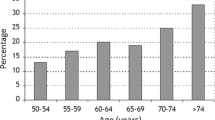Abstract
Summary
High prevalence of vertebral fractures (17.9 % over all; 18.8 % male and 17.1 % female) was observed in 808 free-living residents of Delhi, India, aged more than 50 years. The prevalence rates were comparable to that reported in Caucasian populations. While there was an increase in fracture prevalence with age in females, the same was not observed in males.
Introduction
The aim of this paper is to study the prevalence of and risk factors for morphometric vertebral fractures in elderly Indian men and women over 50 years of age.
Methods
We recruited 808 healthy subjects aged 50 years or more, residing in three residential colonies in Delhi, India who voluntarily agreed to participate in this study. All subjects underwent lateral X-rays of the lumbar and thoracic spine according to a standardized protocol. All X-rays were blindly evaluated by a single trained person using an advanced semi-automated software (Optasia Medical) based on Genant’s semiquantitative method. Recruited subjects underwent anthropometric, biochemical, and hormonal evaluation.
Results
With a mean age of 64.9 (±6.7) years, 345 males and 415 females were evaluated. Vertebral fractures were present in 17.9 % (95 % CI 15.2, 20.6) subjects [males, 18.8 % (95 % CI 14.6, 23), females 17.1 % (95 % CI 13.5, 20.8)]. Prevalence of vertebral fractures increased with age in females from 14.7 % in 50–59 years age group to 22.4 % in those ≥70 years, but not in men. Overweight subjects had significantly lower risk [OR, 0.63 (95 % CI 0.41, 0.97), p = 0.035] of vertebral fractures. Serum 25 hydroxyvitamin D levels, intake of calcium and vitamin D, or history of previous fractures were not statistically different between patients with or without prevalent vertebral fractures.
Conclusions
The prevalence of vertebral fractures among older Indians was comparable to that reported in Caucasian populations. Prevalence of vertebral fractures increased with age in females, but not in males. Overweight individuals were protected against vertebral fractures.



Similar content being viewed by others
References
Ensrud KE, Schousboe JT (2011) Vertebral fractures. N Engl J Med 364:1634–1642
Diacinti D, Guglielmi G (2010) Vertebral morphometry. Radiol Clin North Am 48:561–575
Griffith JF, Guglielmi G (2010) Vertebral fracture. Radiol Clin North Am 48:519–529
Gupta A (1998) Osteoporosis in India—the nutritional hypothesis. In: Mithal A, Rao DS, Zaidi M (eds) Metabolic bone disorders. Hindustan Book Depot, Lucknow, pp 115–132
SpineAnalyzer™ 3.2 Demonstrator Edition User Guide. Published 27 November 2009
Schousboe JT, Vokes T, Broy SB, Ferrar L, McKiernan F, Roux C, Binkley N (2008) Vertebral fracture assessment: the 2007 ISCD official positions. J Clin Densitom 11:92–108
Brett A, Miller CG, Hayes CW, Krasnow J, Ozanian T, Abrams K, Block JE, Van Kuijk C (2009) Development of a clinical workflow tool to enhance the detection of vertebral fractures: accuracy and precision evaluation. Spine 34:2437–2443
Nongkynrih B (2004) The prevalence of fragility fractures amongst post-menopausal women in rural Haryana: a community based study. Indian J Prev Soc Med 35:146–155
O’Neill TW, Felsenberg D, Varlow J et al (1996) The prevalence of vertebral deformity in european men and women: the European Vertebral Osteoporosis Study. J Bone Miner Res 11:1010–1018
Jackson SA, Tenenhouse A, Robertson L et al (2000) Vertebral fracture definition from population based data: preliminary results from the Canadian Multicenter Osteoporosis Study (CaMos). Osteoporos Int 11:680–687
Ho-Pham LT, Nguyen ND, Vu BQ, Pham HN, Nguyen TV (2009) Prevalence and risk factors of radiographic vertebral fracture in postmenopausal Vietnamese women. Bone 45:213–217
Sanfélix-Genovés J, Reig-Molla B, Sanfélix-Gimeno G, Peiró S, Graells-Ferrer M, Vega-Martínez M, Giner V (2010) The population-based prevalence of osteoporotic vertebral fracture and densitometric osteoporosis in postmenopausal women over 50 in Valencia, Spain (the FRAVO Study). Bone 47:610–616
Ling X, Cummings SR, Mingwei Q, Xihe Z, Xioashu C, Nevitt M, Stone K (2000) Vertebral fractures in Beijing, China: the Beijing Osteoporosis Project. J Bone Miner Res 15:2019–2025
Clark P, Cons-Molina F, Deleze M et al (2009) The prevalence of radiographic vertebral fractures in Latin American countries: the Latin American Vertebral Osteoporosis Study (LAVOS). Osteoporos Int 20:275–282
Black DM, Palermo L, Nevitt MC et al (1995) Comparison of methods for defining prevalent vertebral deformities: the study of osteoporotic fractures. J Bone Miner Res 10:890–902
Freitas SS, Barrett-Connor E, Ensrud KE, Fink HA, Bauer DC, Cawthon PM, Lambert LC, Orwoll ES (2008) Rate and circumstances of clinical vertebral fractures in older men. Osteoporos Int 19(5):615–623
Malhotra N, Mithal A (2008) Osteoporosis in Indians. Indian J Med Res 127:263–268
Acknowledgments
The study was supported in part by research grants from the Institute of Nuclear Medicine and Allied Sciences (INMAS), New Delhi. We also acknowledge the valuable assistance provided by Brig. Satish Kukreja (Retd), Honorary CEO, Indian Society for Bone and Mineral Research in executing the study. We would like to acknowledge the assistance provided by the following research staff: Madan Prasad, Abhishek Kaushik, and Meeta Rautela. Finally, we would like to thank the office bearers of the participating Residence Welfare Associations and the volunteers.
Conflict of interest
None.
Author information
Authors and Affiliations
Corresponding author
Additional information
Raman K. Marwaha and Nikhil Tandon contributed equally to this paper.
Electronic supplementary material
Below is the link to the electronic supplementary material.
ESM Table 1
Risk factors for vertebral fracture (males; doc 50 kb)
ESM Table 2
Risk factors for vertebral fracture (females; doc 50 kb)
Rights and permissions
About this article
Cite this article
Marwaha, R.K., Tandon, N., Gupta, Y. et al. The prevalence of and risk factors for radiographic vertebral fractures in older Indian women and men: Delhi Vertebral Osteoporosis Study (DeVOS). Arch Osteoporos 7, 201–207 (2012). https://doi.org/10.1007/s11657-012-0098-8
Received:
Accepted:
Published:
Issue Date:
DOI: https://doi.org/10.1007/s11657-012-0098-8




